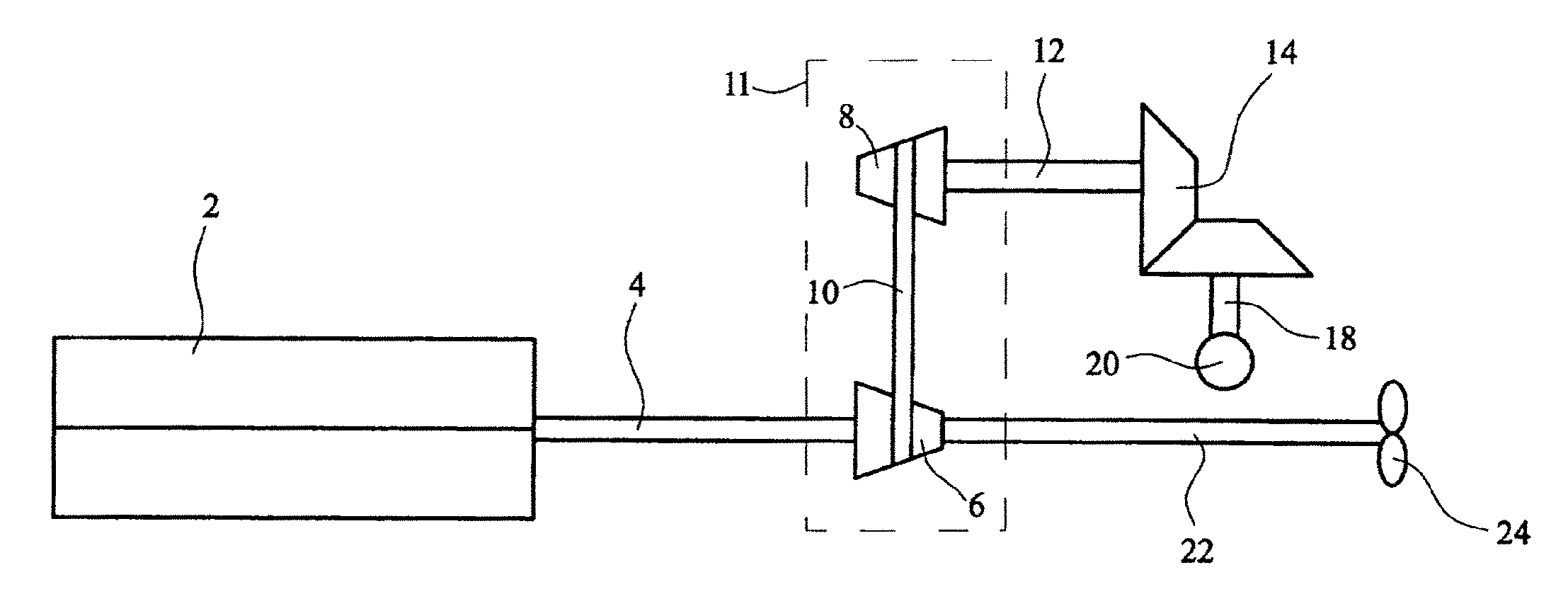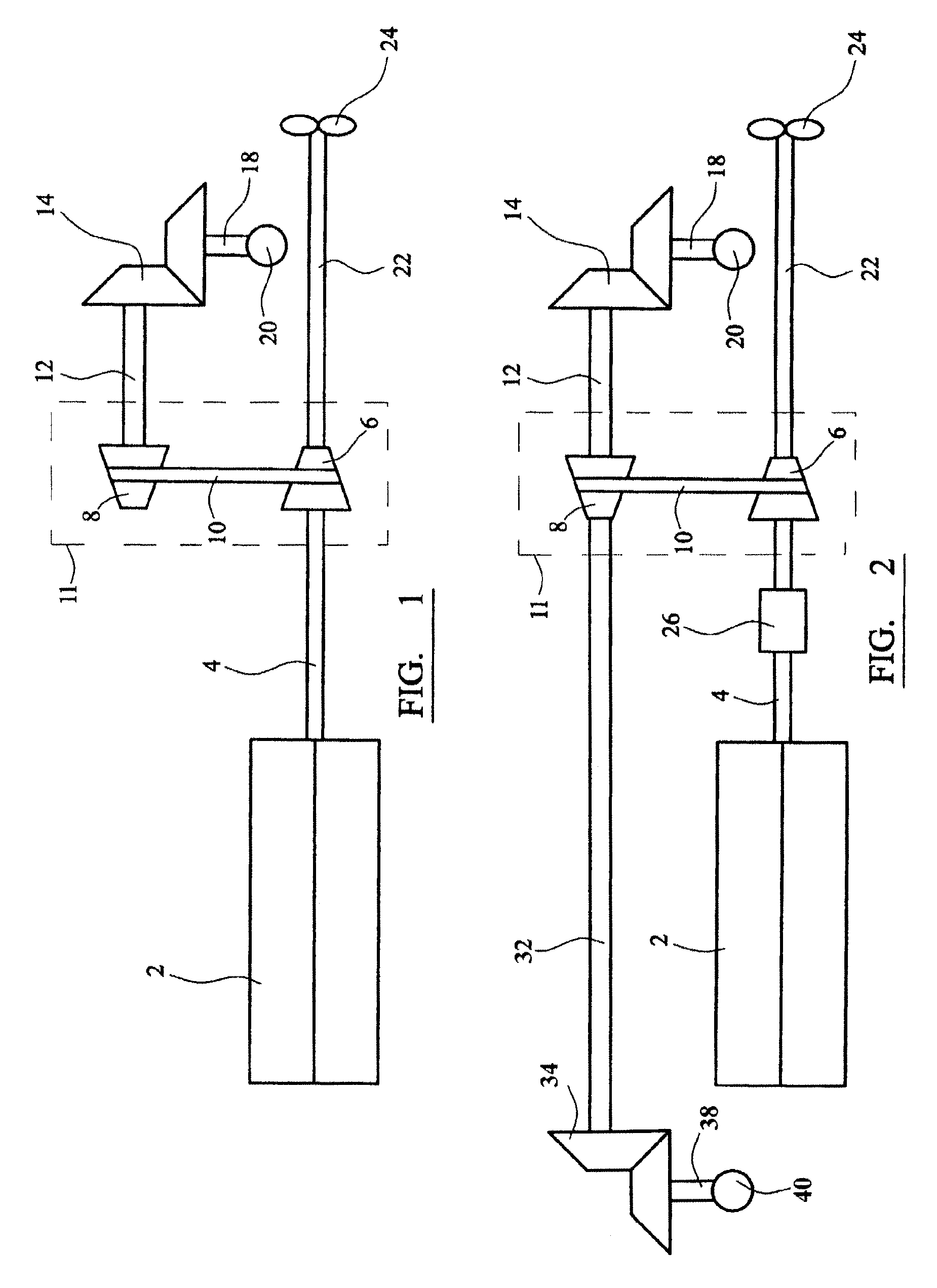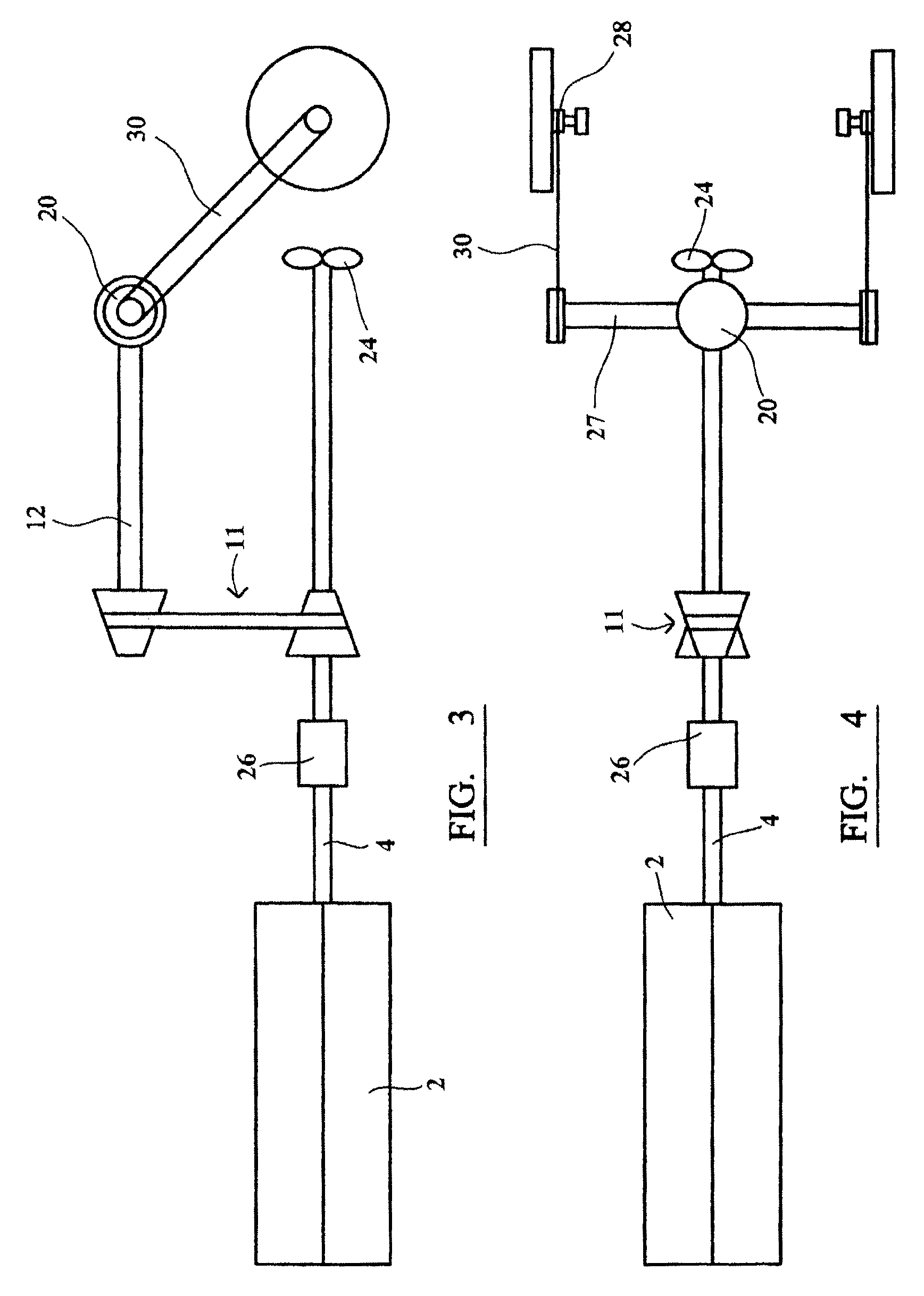Amphibious vehicle power trains
Jeffery , et al. A
U.S. patent number 10,744,829 [Application Number 15/707,533] was granted by the patent office on 2020-08-18 for amphibious vehicle power trains. This patent grant is currently assigned to Gibbs Technologies LTD. The grantee listed for this patent is Gibbs Technologies LTD. Invention is credited to Stephen John Briggs, Glen Michael Jeffery, Simon James Longdill, Hans Weekers.



| United States Patent | 10,744,829 |
| Jeffery , et al. | August 18, 2020 |
Amphibious vehicle power trains
Abstract
An amphibious vehicle power train having an engine (2) with an output shaft (4), driving an input member (6) of a variable speed change transmission (11). The speed change transmission, which may be a continuously variable transmission is arranged to drive road wheels through an output member (8). The engine also drives a marine propulsion unit (24). The axis of the output member (8) is above the axis of the input member (6). Four wheel drive may be provided (FIG. 2).
| Inventors: | Jeffery; Glen Michael (Auckland, NZ), Weekers; Hans (Auckland, NZ), Longdill; Simon James (Auckland, NZ), Briggs; Stephen John (Auckland, NZ) | ||||||||||
|---|---|---|---|---|---|---|---|---|---|---|---|
| Applicant: |
|
||||||||||
| Assignee: | Gibbs Technologies LTD
(Nuneaton, GB) |
||||||||||
| Family ID: | 34113029 | ||||||||||
| Appl. No.: | 15/707,533 | ||||||||||
| Filed: | September 18, 2017 |
Prior Publication Data
| Document Identifier | Publication Date | |
|---|---|---|
| US 20180065434 A1 | Mar 8, 2018 | |
Related U.S. Patent Documents
| Application Number | Filing Date | Patent Number | Issue Date | ||
|---|---|---|---|---|---|
| 13907714 | May 31, 2013 | 9764611 | |||
| 11793936 | Jun 4, 2013 | 8454398 | |||
| PCT/GB2005/005001 | Dec 21, 2005 | ||||
Foreign Application Priority Data
| Dec 22, 2004 [GB] | 0428055.8 | |||
| Current U.S. Class: | 1/1 |
| Current CPC Class: | B60F 3/0053 (20130101); B60F 3/0007 (20130101); B60F 3/00 (20130101) |
| Current International Class: | B60F 3/00 (20060101) |
| Field of Search: | ;440/12.5,12.51,12.54,12.57 |
References Cited [Referenced By]
U.S. Patent Documents
| 1550344 | August 1925 | Copes |
| 2350037 | May 1944 | Hofheins et al. |
| 2878883 | March 1959 | Le et al. |
| 3446174 | May 1969 | Ballu |
| 3450089 | June 1969 | Lippincott |
| 3903831 | September 1975 | Bartlett |
| 4257505 | March 1981 | Stodt |
| 5531179 | July 1996 | Roycroft et al. |
| 5562066 | October 1996 | Gere et al. |
| 5690046 | November 1997 | Grzech, Jr. |
| 6575796 | June 2003 | McDowell |
| 6626712 | September 2003 | Bellezza Quater et al. |
| 6672916 | January 2004 | Lent-Phillips et al. |
| 6764358 | July 2004 | Gibbs |
| 6776672 | August 2004 | Roycroft |
| 6957991 | October 2005 | Gibbs |
| 7011557 | March 2006 | Gibbs |
| 7089822 | August 2006 | Gibbs et al. |
| 7214112 | May 2007 | Gibbs |
| 7410396 | August 2008 | Longdill et al. |
| 7416457 | August 2008 | Gibbs |
| 7425103 | September 2008 | Perez-Sanchez |
| 7713102 | May 2010 | Longdill et al. |
| 7770483 | August 2010 | Gibbs |
| 8454398 | June 2013 | Jeffery |
| 9764611 | September 2017 | Jeffery |
| 1530577 | Dec 1969 | DE | |||
| 3916200 | Nov 1990 | DE | |||
| 19926145 | Dec 2000 | DE | |||
| 2181604 | Dec 1973 | FR | |||
| 142120 | Jul 1921 | GB | |||
| 184294 | Aug 1922 | GB | |||
| 350257 | Jun 1931 | GB | |||
| 2134857 | Aug 1984 | GB | |||
| 2000001559 | Jan 2000 | JP | |||
| 2243109 | Dec 2004 | RU | |||
| 1752584 | Aug 1992 | SU | |||
Attorney, Agent or Firm: Fulwider Patton LLP
Parent Case Text
CROSS-REFERENCES TO RELATED APPLICATIONS
This application is a continuation of application U.S. application Ser. No. 13/907,714 filed May 31, 2013, which is a continuation of U.S. application Ser. No. 11/793,936 filed Aug. 8, 2008, now U.S. Pat. No. 8,454,398, which is a national phase of PCT/GB05/05001, filed Dec. 21, 2005, which claims priority from Great Britain Application No. 0428055.8, filed Dec. 22, 2004, incorporated by reference in its entirety.
Claims
We claim:
1. An amphibious vehicle power train for an amphibious vehicle having one or more retractable wheels, the amphibious vehicle power train comprising an engine having an engine output shaft, a marine propulsion unit, a variable speed change transmission and road wheels, the speed change transmission having an input member and a first output member arranged to interact with the input member, the first output member having an output axis at a higher level than, or laterally offset relative to, an axis of the engine output shaft, the road wheels being arranged to be driven by, or via, the first output member.
2. An amphibious vehicle power train as claimed in claim 1 wherein the output axis of first output member is substantially parallel to an axis of the input member and to the axis of the engine output shaft.
3. An amphibious vehicle power train as claimed in claim 1 wherein the speed change transmission has a further output member which is arranged to drive the marine propulsion unit.
4. An amphibious vehicle power train as claimed in claim 3, wherein the further output member has an axis at a level below, and/or laterally offset relative to, the output axis of the first output member.
5. An amphibious vehicle power train as claimed in claim 1 wherein the speed change transmission is mounted such that an axis of the input member and the output axis of the first output member are at a level above, and/or laterally offset relative to, the axis of the engine output shaft.
6. An amphibious vehicle power train as claimed in claim 1 wherein the speed change transmission is a continuously variable transmission in which the interaction between the input member and the first output member is provided by means of a belt.
7. An amphibious vehicle power train as claimed in claim 1 wherein the input member and the first output member have conical driving and driven surfaces respectively.
8. An amphibious vehicle power train as claimed in claim 1 wherein a speed reduction gearbox is provided between the engine and the speed change transmission or on the engine output shaft.
9. An amphibious vehicle power train as claimed in claim 1 wherein the speed change transmission offers a plurality of ratios of input member speed to output member speed.
10. An amphibious vehicle power train as claimed in claim 1 further comprising a forward drive shaft having an axis which is at a higher level than, or laterally offset relative to, the axis of the engine output shaft, such that the forward drive shaft extends above, or laterally alongside, at least some parts of the engine to drive at a least one road wheel.
11. An amphibious vehicle power train as claimed in claim 1 further comprising a marine driveshaft arranged to drive a marine propulsion unit.
12. An amphibious vehicle power train as claimed in claim 1 further comprising a marine driveshaft, wherein the marine driveshaft has an axis which is longitudinally aligned with the axis of the engine output shaft.
13. An amphibious vehicle power train as claimed in claim 1 further comprising a marine driveshaft, wherein the marine driveshaft is coupled to the input member of the variable speed change transmission.
14. An amphibious vehicle power train as claimed in claim 1 wherein the speed change transmission comprises a conventional manual gearbox, a semi-automated manual gearbox, or a fully automatic transmission.
Description
BACKGROUND
The present invention relates to amphibious vehicles and in particular to power trains for such vehicles.
In one power train layout for an amphibious vehicle, as described in the applicant's co-pending application no. GB0422954.8, an engine is arranged so that its crankshaft drives a gearbox from which road and marine drive outputs are taken. The road drive is turned through an angle of up to 90.degree. by means of a bevel gearbox so as to provide an upwardly angled drive to a continuously variable transmission (CVT) speed change unit of the sort having two pulleys interconnected by a belt, which belt runs in a substantially horizontal plane. The output of the CVT unit then by means of a further substantially vertical shaft drives a differential coupled to the rear road wheels.
A problem with the aforesaid arrangement is that the provision of the CVT unit much above the crankshaft axis tends to cause vibration; while the location of the CVT unit weighing up to say 30 kg increases the amphibious vehicle's top weight. This in turn raises the vehicle's centre of gravity and increases its metacentric height, which deleteriously affects vehicle handling on both land and water.
SUMMARY OF THE INVENTION
Accordingly, the present invention provides an amphibious vehicle power train as claimed in claim 1. This improved power train arrangement retains the advantages of the prior arrangement in packaging terms, with reduced vibration and improved weight distribution. Where retractable wheels are provided, it is desirable for such wheels to be clear of water when the vehicle banks into turns on water. The geometry of wheel retraction may force the differential(s) to be mounted well above the bottom of the hull; particularly where a deep vee hull is provided to optimize vehicle handling on water. The power train claimed allows the road drive to leave the speed change transmission at a level above the engine output shaft, which in turn allows the mass of the engine to be kept low in the vehicle. This keeps the centre of gravity low, and maximizes metacentric height. These effects minimize vehicle roll and maximize stability on both land and water.
Where the marine drive is level with the engine output shaft, this ensures a substantially straight run from the engine output shaft to the marine drive. Prior art marine drives such as Aquastrada (U.S. Pat. No. 5,562,066) and Simpson (GB 2,134,857) comprise angled drives to the marine drive, which can waste power and create vibration and durability problems.
It should be noted that wherever a speed change transmission is referred to hereinafter in this specification, this is a variable speed transmission offering a plurality of ratios of input member speed to output member speed.
Reference will now be made to embodiments of the invention illustrated in the accompanying drawings, by way of example only.
BRIEF DESCRIPTION OF THE DRAWINGS
FIG. 1 is a schematic side elevation of a power train for an amphibious vehicle;
FIG. 2 is a schematic side elevation of a power train for an amphibious vehicle incorporating a reduction gearbox on the engine output shaft;
FIG. 3 is a schematic side elevation of an alternative configuration of power train for an amphibious vehicle; and
FIG. 4 is a schematic plan elevation of the alternative version of the power train as illustrated in FIG. 3.
DETAILED DESCRIPTION OF THE PREFERRED EMBODIMENTS
With reference to FIG. 1, engine 2 supplies drive via output shaft 4. Continuously Variable Transmission (CVT) input member 6 is mounted on the end of the engine output shaft 4, and connected to a CVT output member 8 via drive belt 10. The CVT output member 8 is provided with a CVT output shaft 12, which drives a bevel gearbox 14 driving down to a differential 20 with a vertical input 18. The CVT input and output members 6, 8 and drive belt 10 form a speed change transmission 11.
The marine propulsion unit 24 receives drive via marine driveshaft 22.
FIG. 2 illustrates the power drive of FIG. 1 with a reduction gearbox 26 provided on engine output shaft 4. This figure also shows a four-wheel-drive system, with drive taken forward from CVT output member 8 through driveshaft 32 to a forward bevel gearbox 34, which in turn drives front wheels (not shown) through differential 40 with vertical input 38.
FIG. 3 shows an alternative embodiment of the power train, with the differential 20 placed at the back of the CVT output shaft 12, with driveshafts 27 driving down to wheel driveshafts 28 by chains or belts 30.
FIG. 4 is a schematic plan elevation of the alternative version of the power train as illustrated in FIG. 3.
Although a longitudinally mounted "North-South" engine is shown, the transmission layout may in a further embodiment be used with a transverse engine; or even with a vertical crankshaft engine, as is known in marine prior art. Although an engine output shaft separate to an engine crankshaft is shown, said output shaft may be the engine crankshaft; or the prime rotating shaft of an electric motor.
The transmission output shaft 12, as shown in FIG. 1, is above the level of the top of the engine; broadly a prime mover; or at least above all rotating parts thereof. The transmission output shaft may be directly above the input shaft, which is the engine output shaft 4, to allow a forward drive shaft 32 to pass above the engine. In a further embodiment, the output shaft may be laterally offset relative to the input shaft, enabling a lower centre of gravity by running the forward drive shaft alongside at least some parts of the prime mover. In another embodiment, a centre differential is connected to the forward driveshaft 32, to enable speed difference and torque division between front and rear axles.
The marine, propulsion unit 24 is shown diagrammatically, since it may comprise one or more jet drives. The reduction gearbox 26 is shown as being between the engine and both road and marine drives; but in another embodiment (not shown), it is connected only to the marine drive. In a further embodiment (not shown), the reduction gearbox is connected only to the road drive. Depending on the characteristics of the prime mover chosen, a speed increase gearbox may be used instead; or even a range change gearbox, particularly where all road wheels are driven. Where a CVT is used without a reverse gear, a separate reversing drive may be supplied, as shown in the applicant's co-pending application no. GB0422954.8 (item 110, FIG. 6). Clutches or decouplers may be fitted to the road or marine drive, or to both.
As the power train layout described is essentially tall and narrow, it is particularly suited to a vehicle with passenger seating (not shown) arranged above the power train; more particularly, in line astern. It is also particularly suited to a vehicle whose road wheels are retractable above the vehicle water line to reduce hydrodynamic drag when the vehicle is used on water. The wheel retraction may be at an angle to the road going position, as shown in the applicant's co-pending application no. GB0422954.8 (FIG. 1).
The seating and wheel retraction arrangements described above are particularly suited to a planing vehicle; and especially to a planing vehicle with a deep vee hull.
It will be appreciated that various changes may be made to the above described embodiment without departing from the fundamental inventive concept. For example, the speed change transmission unit may be a conventional manual gearbox; a semi-automated manual gearbox; or a fully automatic transmission with torque converter and hydraulic drive, as is well known in road vehicles. The term engine may mean an internal combustion engine, but the transmission layout described could be found equally suitable to an external combustion engine, or indeed to a fuel cell and motor combination.
* * * * *
D00000

D00001

D00002

XML
uspto.report is an independent third-party trademark research tool that is not affiliated, endorsed, or sponsored by the United States Patent and Trademark Office (USPTO) or any other governmental organization. The information provided by uspto.report is based on publicly available data at the time of writing and is intended for informational purposes only.
While we strive to provide accurate and up-to-date information, we do not guarantee the accuracy, completeness, reliability, or suitability of the information displayed on this site. The use of this site is at your own risk. Any reliance you place on such information is therefore strictly at your own risk.
All official trademark data, including owner information, should be verified by visiting the official USPTO website at www.uspto.gov. This site is not intended to replace professional legal advice and should not be used as a substitute for consulting with a legal professional who is knowledgeable about trademark law.